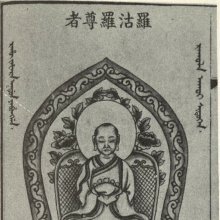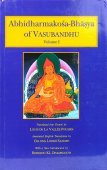Rahula, Rāhula, Rāhulā: 12 definitions
Introduction:
Rahula means something in Buddhism, Pali, Hinduism, Sanskrit, the history of ancient India. If you want to know the exact meaning, history, etymology or English translation of this term then check out the descriptions on this page. Add your comment or reference to a book if you want to contribute to this summary article.
Images (photo gallery)
In Hinduism
Purana and Itihasa (epic history)
Source: Cologne Digital Sanskrit Dictionaries: The Purana IndexRāhula (राहुल).—Son of Śuddhodana, and father of Prasenajit.*
- * Vāyu-purāṇa 99. 289; Viṣṇu-purāṇa IV. 22. 8.

The Purana (पुराण, purāṇas) refers to Sanskrit literature preserving ancient India’s vast cultural history, including historical legends, religious ceremonies, various arts and sciences. The eighteen mahapuranas total over 400,000 shlokas (metrical couplets) and date to at least several centuries BCE.
In Buddhism
Theravada (major branch of Buddhism)
Source: Pali Kanon: Pali Proper Names1. Rahula Thera
Only son of Gotama Buddha. He was born on the day on which his father left the household life (J.i.60; AA.i.82, etc.; cf. J.i.62). When the Buddha visited Kapilavatthu for the first time after his Enlightenment and accepted Suddhodanas invitation, Rahulas mother (Rahulamata) sent the boy to the Buddha to ask for his inheritance (dayajja). The Buddha gave him no answer, and, at the conclusion of the meal, left the palace. Rahula followed him, reiterating his request until at last the Buddha asked Sariputta to ordain him. (According to SNA.i.340, Moggallana taught him the kammavaca; see also J.ii.393). When Suddhodana heard of this he protested to the Buddha, and asked as a boon that, in future, no child should be ordained without the consent of his parents, and to this the Buddha agreed (Vin.i.82f.; the story of Rahulas conversion is also given at DhA.i.98f).
It is said (AA.i.145) that immediately after Rahulas ordination the Buddha preached to him constantly (abhinhovadavasena) many suttas for his guidance. Rahula himself was eager to receive instruction from the Buddha and his teachers and would rise early in the morning and take a handful of sand, saying: May I have today as many words of counsel from my teachers as there are here grains of sand! The monks constantly spoke of Rahulas amenability, and one day the Buddha, aware of the subject of their talk, went amongst them and related the Tipallatthamiga Jataka (J.i.160ff ) and the Tittira Jataka (J.iii.64ff ) to show them that in past births, too, Rahula had been known for his obedience. When Rahula was seven years old, the Buddha preached to him the Ambalatthika Rahulovada Sutta (q.v.) as a warning that he should never lie, even in fun. Rahula used to accompany the Buddha on his begging rounds. Sometimes he would accompany Sariputta on his begging rounds. He was present when Sariputta went to his (Sariputtas) mothers house, where he was roundly abused by her for having left her. DhA.iv.164f).
Rahula noticed that he harboured carnal thoughts fascinated by his own physical beauty and that of his father, the Buddha preached to him, at the age of eighteen, the Maha Rahulovada Sutta (q.v.). Two other suttas, also called Rahulovada, one included in the Samyutta and the other in the Anguttara (see below), formed the topics for Rahulas meditation (Vipassana). To these Suttas Buddhaghosa (MA.i.635) adds the Samanera, or Kumarapanha, and proceeds to enumerate the different purposes which the Buddha had in view in preaching these suttas; see also AA.ii.547. SNA.i.340 says, about the Rahula Sutta (q.v.), that the Buddha constantly preached it to Rahula. See also the Rahula Samyutta.
Later, the Buddha, knowing that Rahulas mind was ripe for final attainment, went with him alone to Andhavana,
Theravāda is a major branch of Buddhism having the the Pali canon (tipitaka) as their canonical literature, which includes the vinaya-pitaka (monastic rules), the sutta-pitaka (Buddhist sermons) and the abhidhamma-pitaka (philosophy and psychology).
Tibetan Buddhism (Vajrayana or tantric Buddhism)
Source: Wisdom Library: Tibetan BuddhismRāhula (राहुल) is the name of a Śrāvaka mentioned as attending the teachings in the 6th century Mañjuśrīmūlakalpa: one of the largest Kriyā Tantras devoted to Mañjuśrī (the Bodhisattva of wisdom) representing an encyclopedia of knowledge primarily concerned with ritualistic elements in Buddhism. The teachings in this text originate from Mañjuśrī and were taught to and by Buddha Śākyamuni in the presence of a large audience (including Rāhula).
Source: Himalayan Art: GeneralRahula, the Elder: the actual son of the buddha Shakyamuni and the 10th arhat from the set of sixteen Great Arhats. Rahula has a number of different ways in which he is depicted. The most common depiction in Tibetan art is for him to be holding up a jeweled crown with both hands. Chinese depictions often have him holding a staff in one hand and a tiger or lion seated at his feet. The iconography of the arhats is not fixed in art or literature.
Rahula; Tibetan: Neten Drachen Dzin (gnas brtan sgra g.can 'dzin)
Rahula, the Elder (Tibetan: ne ten, dra chen dzin, Sanskrit: Sthavira Rahula)
Rāhula is the name of a mahāsiddha, of which eighty-four in total are recognized in Vajrayāna (tantric buddhism). His title is “the rejuvenated dotard”. He lived somewhere between the 8th and the 12th century AD.
These mahāsiddhas (e.g., Rāhula) are defined according to the Abhayadatta Sri (possibly Abhayākaragupta) tradition. Its textual origin traces to the 11th century caturāsiti-siddha-pravṛtti, or “the lives of the eighty-four siddhas”, of which only Tibetan translations remains. Rāhula (and other Mahāsiddhas) are the ancient propounders of the textual tradition of tantric or Vajrayana Buddhism.

Tibetan Buddhism includes schools such as Nyingma, Kadampa, Kagyu and Gelug. Their primary canon of literature is divided in two broad categories: The Kangyur, which consists of Buddha’s words, and the Tengyur, which includes commentaries from various sources. Esotericism and tantra techniques (vajrayāna) are collected indepently.
Mahayana (major branch of Buddhism)
Source: Wisdom Library: Maha Prajnaparamita SastraRāhula (राहुल) is the name of the son of the Buddha according to the 2nd century Mahāprajñāpāramitāśāstra (chapter XXII).—Accordingly, “When Lo heou lo (Rāhula) was a child, he was careless about his speech. When the Buddha was present and someone came to ask Rāhula: ‘Is the Buddha here?’, Rāhula answered mischievously: ‘He is not here’. When the Buddha was absent and someone asked Rāhula: ‘Is the Bhagavat here?’, he answered mischievously: ‘The Buddha is here’. Some people reported this to the Buddha, who said to Rāhula: ‘Go and get some water in a basin (udākadhāna) and wash my feet’.”.

Mahayana (महायान, mahāyāna) is a major branch of Buddhism focusing on the path of a Bodhisattva (spiritual aspirants/ enlightened beings). Extant literature is vast and primarely composed in the Sanskrit language. There are many sūtras of which some of the earliest are the various Prajñāpāramitā sūtras.
General definition (in Buddhism)
Source: Buddhist Door: GlossaryHe was one of the Ten Great Disciples of Shakyamuni. He was the first in esoteric practices and in desire for instruction in the Law. He was also the son of Shakyamuni.India history and geography
Source: archive.org: Nilamata Purana: a cultural and literary study (history)Rāhulā (राहुला) is the name of a river mentioned in the Nīlamatapurāṇa that remains unidentified.

The history of India traces the identification of countries, villages, towns and other regions of India, as well as mythology, zoology, royal dynasties, rulers, tribes, local festivities and traditions and regional languages. Ancient India enjoyed religious freedom and encourages the path of Dharma, a concept common to Buddhism, Hinduism, and Jainism.
Languages of India and abroad
Sanskrit dictionary
Source: Cologne Digital Sanskrit Dictionaries: Edgerton Buddhist Hybrid Sanskrit DictionaryRāhula (राहुल).—(1) (= Pali id.; Aśokan Lāghula with gh, held to be older than h, but quite possibly hyper-Sanskrit) name of Śākyamuni's son; also Rāhulabhadra (= Pali °bhadda), so in Mahāvastu i.154.3; iii.175.16, 19; Gaṇḍavyūha 51.11; Saddharmapuṇḍarīka 219.12; 220.2; also Rāhulaśiri Mahāvastu i.128.13 (°śirisya, gen.); iii.271.3 (°śiriṃ); his birth was miraculous but not aupa- pāduka, Mahāvastu i.153.8, 14; 154.3; he descended from the Tuṣita heaven into Yaśodharā's womb, Mahāvastu ii.159.3; dis- covers that the Buddha is his father and insists on becom- ing a monk, Mahāvastu iii.257.17 ff.; is ordained by Śāriputra at the Buddha's command, 268.5 ff.; remained 6 years in his mother's womb because of an offense against the Bodhisattva in a former birth, Mahāvastu iii.172.5; 175.16, 19; in a list of 8 mahāśrāvaka (Ārya-)Mañjuśrīmūlakalpa 111.12; No. 33 of a list of 34 mahāśrāvaka Sukhāvatīvyūha 2.11; last of 26 mahāśrāvaka, Saddharmapuṇḍarīka 2.8; in list of śrāvaka Mahāvyutpatti 1039; of bhikṣus, Lalitavistara 2.3; other references Mahāvastu i.170.4; ii.114.7; iii.142.15 et alibi (see Index); Saddharmapuṇḍarīka 215.3; 220.5, 9; Sukhāvatīvyūha 92.7 (as a mahāśrā- vaka); Suvarṇabhāsottamasūtra 12.12; 200.9; Yaśodharā is called Rāhulaśirisya mātā Mahāvastu i.128.13; Rāhulasya jananī Mahāvastu ii.135.14, and compare next; (2) name of a cakravartin king: Mahāvyutpatti 3611.
Source: Cologne Digital Sanskrit Dictionaries: Monier-Williams Sanskrit-English Dictionary1) Rāhula (राहुल):—[from rāhu] m. Name of a man, [Pravara texts]
2) [v.s. ...] of a son of Gautama Buddha, [Monier-Williams’ Buddhism 25; 193]
3) [v.s. ...] of a son of Śuddhodana, [Viṣṇu-purāṇa] ([varia lectio] for rātula)
4) [v.s. ...] of a minister, [Buddhist literature]
[Sanskrit to German]
Sanskrit, also spelled संस्कृतम् (saṃskṛtam), is an ancient language of India commonly seen as the grandmother of the Indo-European language family (even English!). Closely allied with Prakrit and Pali, Sanskrit is more exhaustive in both grammar and terms and has the most extensive collection of literature in the world, greatly surpassing its sister-languages Greek and Latin.
See also (Relevant definitions)
Starts with: Rahulabhadda, Rahulabhadra, Rahulaka, Rahulamata, Rahulamatar, Rahulasu, Rahulata.
Ends with: Kumbarahula.
Full-text (+73): Yashodhareya, Rahulabhadra, Ratula, Rahulasu, Rahulabhadda, Rahulamatar, Apagata Sutta, Pathavindhara, Buddhippasadini, Vasula, Yashodhara, Jalambara, Tipallatthamiga Jataka, Saptaratnapadmavikrantagamin, Cula Rahulovada Sutta, Krishna, Samphassa Sutta, Rahulamata, Bauddhadarshana, Shuddhoda.
Relevant text
Search found 79 books and stories containing Rahula, Rāhula, Rāhulā; (plurals include: Rahulas, Rāhulas, Rāhulās). You can also click to the full overview containing English textual excerpts. Below are direct links for the most relevant articles:
Vinaya Pitaka (1): Bhikkhu-vibhanga (the analysis of Monks’ rules) (by I. B. Horner)
Monks’ Expiation (Pācittiya) 5
Monks’ Expiation (Pācittiya) 29
Monks’ Expulsion (Pārājika) 4: Permutations < [Monks’ Expulsion (Pārājika) 4]
Maha Prajnaparamita Sastra (by Gelongma Karma Migme Chödrön)
Appendix 2 - The complaint of Rāhula to the Buddha < [Chapter IV - Explanation of the Word Bhagavat]
Story of exhortations to Rāhula < [Section I.4 - Abstention from falsehood]
The story of Yaśodharā < [Part 2 - Means of acquiring meditation]
The Buddha and His Disciples (by Venerable S. Dhammika)
The Gospel of Buddha (by Paul Carus)
The Great Chronicle of Buddhas (by Ven. Mingun Sayadaw)
Part 4 - The Discourse on The Cha-pañcaka < [Chapter 32b - The Buddha’s Fourteenth Vassa at Savatthi]
Part 5 - Discourses delivered by the Buddha with Reference to Venerable Rāhula < [Chapter 31 - The Monk Sudinna, the Son of the Kalanda Merchant]
Part 3 - Delivery of the Rahulovada Sutta to Rāhula < [Chapter 31 - The Monk Sudinna, the Son of the Kalanda Merchant]
The Gardener < [December 1943]
A Glimpse into Sinhalese Poetry < [May, 1928]
Reviews < [February 1948]
Related products





